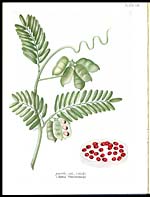Medicine - Veterinary > Veterinary colleges and laboratories > Indian journal of veterinary science and animal husbandry > Volume 2, 1932 > Original articles > Cases of poisoning in the horse with ratti seeds (Abrus precatorius), by oral administration
(75) Page 59
Download files
Individual page:
Thumbnail gallery: Grid view | List view

CASES OF POISONING IN THE HORSE WITH RATTI SEEDS
(ABRUS PRECATORIUS), BY ORAL ADMINISTRATION.
BY
MAJOR K. S. SIMPSON, R.A.V.C.,
AND
P. C. BANERJEE, G.B.V.C.,
Offg. Veterinary Deputy Superintendent, Imperial Institute of Veterinary Research,
Muktesar.
(Received for publication on 13th November 1931.)
(With Plate VII and 2 text-figures.)
In the early part of 1930 there occurred a mysterious outbreak of sickness
among the horses of a Regiment stationed in Northern India.
A horse was reported to have fallen down in the Squadron Lines, and was
unable to get up.
The case seemed one in which an injury, involving the spinal column, had
taken place. Attempts to get the animal to stand failed, so the stall was made as
comfortable as possible, stimulant liniment applied to the spine, and a dose of
Ammon Carb. and Nux Vomica administered. Orders were given to the Veterinary
Assistant Surgeon to extract the faeces by hand, and give enemata and saline
purges. The temperature was normal and the pulse slow. There was a general
lassitude and the hind quarters appeared to be paralysed, food and water were
taken in small quantities. The pupil was dilated and there was a slight twitching
of the facial muscles.
The following morning the horse had not improved, but the diagnosis of spinal
injury was abruptly abandoned, when two more horses were reported to be showing
exactly the same symptoms. This pointed to food poisoning, and samples of all
forage were sent to experts for examination. The results were negative. Exa-
mination of samples of drinking water also failed to give any result.
Saline purges were given to all the affected animals, but they soon refused
food and in ten days' time were in such an emaciated condition that it was decided
to destroy them.
( 59 )
Set display mode to: Large image | Zoom image | Transcription
Images and transcriptions on this page, including medium image downloads, may be used under the Creative Commons Attribution 4.0 International Licence unless otherwise stated. ![]()
| Permanent URL | https://digital.nls.uk/75227407 |
|---|
| Description | Covers articles from 1932. |
|---|




